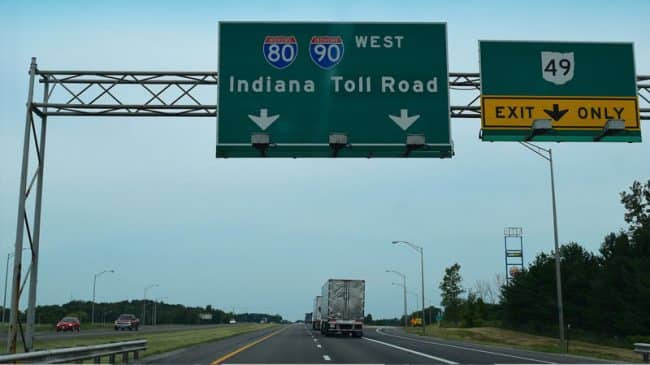Indiana has come under attack as exemplifying the perils of private investment in infrastructure. Since the Trump administration’s $1 trillion infrastructure plan is based largely on this idea of private investment, ideological opponents now seek to portray Indiana’s efforts, under former Governors Mitch Daniels and Mike Pence, as failures. In fact, Indiana’s record of success with public-private partnerships provides a model for the national program.
The state’s first major achievement was the 2006 long-term lease of the state-owned Indiana Toll Road (ITR) for $3.8 billion. ITR was in bad shape, partly because it had not had a toll increase in 20 years — and thus didn’t have sufficient revenue to fund needed maintenance and upgrades. After paying off ITR’s bonds and creating a reserve fund, Gov. Daniels used the rest of the lease proceeds to fully fund a $2.8 billion, 10-year program of statewide highway improvements. And the new Indiana Toll Road Concession Company, which took over control of the toll road in 2006, implemented electronic toll collection, widened a congested portion of the tollway, and modernized the toll plazas as part of a $300 million investment program over its first six years.
This is a prime example of what Australia and Canada call “asset recycling”—selling or leasing government-owned businesses and using the proceeds to invest in other needed infrastructure—without either going into debt or increasing taxes. The idea has been embraced by White House infrastructure advisors Gary Cohn and D. J. Gribbin. Instead of handing out $1 trillion of borrowed money to states and cities, the federal government could instead provide incentives for cities and states to sell or lease government-owned utilities—and use the proceeds to pay for needed infrastructure refurbishment and modernization.
Opponents who instead want massive new federal spending seek to discredit private infrastructure investment, and asset recycling in particular. A recent article in International Business Times portrayed the Indiana Toll Road lease as an abject failure. It pointed out that in 2014 the ITR Concession Company declared bankruptcy, a victim of below-forecast traffic and revenue (thanks in part to the reduced traffic that accompanied the Great Recession) and overly aggressive financing. But it distorted what happened next, claiming that then-Gov. Pence refused to take the toll road back under state operation or to lease it to two Northwest Indiana counties.
What actually happened followed the provisions in the long-term lease agreement. Bondholders and the Indiana Finance Authority put the remaining years of the concession up for bid—and the two counties’ low-ball bid lost, badly. The winning bid, for $5.7 billion, came from Industry Funds Management, on behalf of a set of Australian pension funds. Their offer made the bondholders whole, and led to new, experienced management of the ITR Concession Company. There was no taxpayer bailout of any kind.
Critics of the original deal attacked it for giving away a valuable asset for less than it was worth—and ended up being correct. But that is only because the pension funds saw a sound value proposition in a conservatively financed deal for this valuable long-term asset. Instead of the original company’s 85 percent debt deal, IFM invested 57 percent equity, leaving only 43 percent debt that must be serviced every year, no matter what. That will make it much easier to get through any serious future recession.
IFM’s pension-fund investors will likely be pleased with an 8 percent return on that equity, not the double-digit returns sought by more-aggressive investors. After the deal closed, an array of U.S. pension funds lined up to buy pieces of it, seeing the same value proposition as the Australian funds.
Thus, Indiana’s pioneering asset recycling proved to be a win-win proposition. The new concession company has rebuilt and expanded the aging service plazas along the toll road and is largely finished with an extensive repaving program. Several dozen U.S. pension funds (including the giant California Public Employees’ Retirement System (CalPERS), the largest pension system in the country) have an important addition to their portfolios. And Indiana has moved on to new public-private partnership deals.
Another recent success is the $1.3 billion East End Bridge across the Ohio River to Kentucky, which opened (on time and on-budget) to toll-payers last winter. Indiana’s one glitch was the default of a public-private partnership firm building a 21-mile section of the new I-69 for $325 million. The company had never built a U.S. highway, and should not have been selected. This can be corrected going forward by more-thorough due diligence in pre-qualifying bidders.
Indiana’s next step will be its largest by far. The state has seven other aging Interstate highways. The legislature’s 2017 transportation bill authorized a detailed feasibility study of rebuilding and widening them, using toll financing and potentially long-term public-private partnerships similar to that of the ITR, but emphasizing reconstruction and widening. Indiana does not need federal funding to proceed with this. All it needs is federal permission, in the form of an exemption from the long-standing ban on tolling currently non-tolled Interstates.
This version of asset recycling—based on federal permission to toll—was included in the White House 2018 Infrastructure Fact Sheet, released late in May. That document also called for expanding existing federal financing tools (tax-exempt Private Activity Bonds and gap-filling Transportation Infrastructure Finance and Innovation Act (TIFIA) loans) that have helped finance a growing list of transportation public-private partnerships.
Indiana continues to earn its place as a role model for a new approach to rebuilding America. Critics may not like this approach, but it is paving the way in Indiana and could do likewise across the country.
Robert Poole is director of transportation at Reason Foundation.

